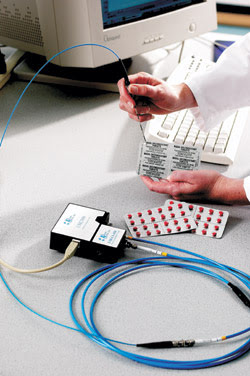With thousands of applications on the books, miniature fiber optic spectrometers have become an attractive option for optical-sensing researchers and product developers.
Rob Morris, Ocean Optics Inc.
In little more than a decade, miniature fiber optic spectroscopy has evolved from a technological curiosity to a proven technique that has helped make possible thousands of optical-sensing applications in hundreds of markets. Today, more than a dozen manufacturers worldwide offer some version of a miniature fiber optic spectrometer — defined here as small enough to be portable and priced at less than $5000 — including platforms for UV, UV-VIS, near-IR, Raman and mass spectroscopy.

Low cost, a small footprint and fiber optic interfaces are among the features that make miniature fiber optic spectrometers attractive for a variety of applications.
These spectrometers have provided an affordable niche market for laboratory professionals, and especially for innovators and early adapters, who use optical-sensing techniques in their research. Indeed, as an enabling technology, miniature fiber optic spectroscopy is common to many industries and disciplines, from chemical processing and wastewater treatment to environmental monitoring and medical diagnostics.
The innovators and early adapters — typically, product and technology developers, as well as OEMs — were the first to recognize the benefits of miniature fiber optic spectrometers. Most important among these benefits are low cost, a palm-size (or smaller) footprint, a fiber optic interface and reliability comparable to lab-grade spectrometers.
Consider costs: Thanks to the availability of low-cost, mass-market detectors, the spectrometers are available for as little as $2000, which has enabled many applications that were previously cost-prohibitive. For example, expensive laboratory spectrophotometers traditionally have been used to monitor the color or chemical composition of a finished product. Now, dozens of inexpensive spectrometer modules can be installed in process lines. This modular approach makes multiple-point sampling and redundant sensing much simpler to integrate into applications, which reduces per-sensor costs and results in more reliable data.
The combination of miniature spectrometers and fiber optics has been a significant development. Optical fiber brings the spectrometer to the sample — whether the sample is on a process line, inside a plasma deposition chamber or in the field — and enables real-time analysis.
In particular, field research has benefited from the marriage of miniature spectroscopy and fiber optics. Biologists have been able to study the role of color in mate selection among birds, reptiles and fish, and in the feeding habits of primates. Botanists have observed the amount of sunlight that penetrates forest canopies. Geologists have monitored sulfur-dioxide emissions from inside active volcanoes. Ecologists have measured pollutants in river basins and contaminants leached into the soil surrounding abandoned underground gasoline tanks.
For example, a team of researchers used miniature fiber optic UV-VIS spectrometers to measure the effects of open-cast mining on coastal erosion, sea grass growth and health of coral reefs in New Caledonia, a small, mineral-rich country east of Australia. Sylvain Ouillon of the Institut de Recherche pour le Développement, along with scientists from universities in France and the US, has used miniature spectrometers to study the transport of fine sediments in coastal zones. Of particular interest is the relationship between above-water spectral reflectance measurements and turbidity profiles — data collected on sediment types, concentrations and flows — especially because the latter is related to fluxes in the presence of metals and various pollutants, and thus, to sea grass growth and coral reef health.
And field researchers aren’t the only ones who have benefited from the instruments. OEMs have long recognized the inherent possibilities of miniature fiber optic spectrometers as the sensing elements of their own analytical devices. For example, NanoDrop Technologies Inc. of Rockland, Del., has integrated a miniature silicon CCD-array detector spectrometer into a system for measuring 1-μl samples of nucleic acids, dye label concentration of DNA microarray probe samples and other genomic material.
As with NanoDrop, government and military researchers have integrated the technology into their research. Not surprisingly, much attention has been focused on homeland security.
Ocean Optics Inc. has licensed a US Army Research Laboratory technology for the detection and quantification of bacterial spores in sample media. This technology has been integrated into a low-cost, portable, fluorescence-based spectroscopic system for instant detection of bacterial endospores — including substances that are suspected to be concentrated forms of anthrax spores — in suspicious powders. In addition, the company is collaborating with the military on projects involving the use of laser-induced breakdown spectroscopy for detecting chemical and biological warfare agents.
What do all these developments portend for miniature fiber optic spectroscopy?
The $2000 PC-based miniature spectrometer has proved that a market exists for low-cost optical-sensing systems. The next major advancement will be to the $200 handheld system. This move will require an architecture that is geared toward meeting application-specific needs in a cost-effective manner. One promising approach is with patterned filters on sensor arrays —mass-produced arrays on a single, micron-scale substrate.
And the potential upside is huge. According to market research company Strategic Directions International of Los Angeles, the market for analytical and life sciences instruments is expected to grow at 5 percent per year, reaching $1.6 billion in 2006.
Meet the author
Rob Morris is director of marketing and customer relations at Ocean Optics Inc. in Dunedin, Fla.